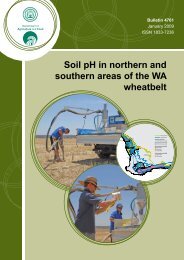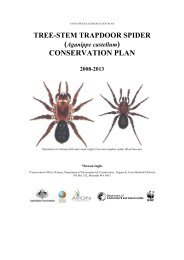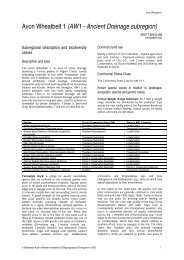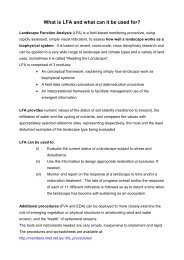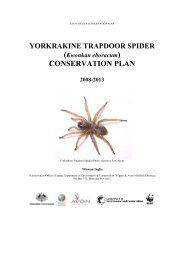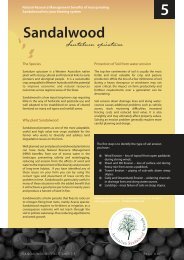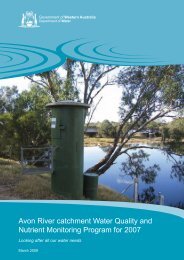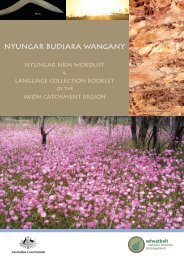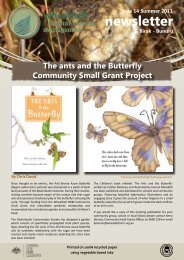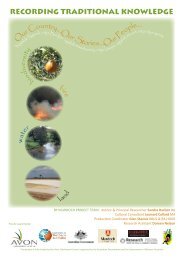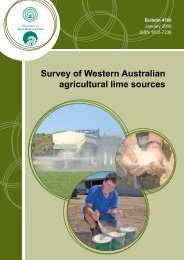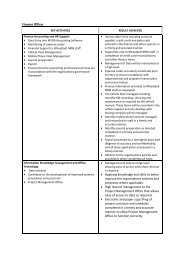Kokerbin Nature Reserve Desktop Fauna ... - Wheatbelt NRM
Kokerbin Nature Reserve Desktop Fauna ... - Wheatbelt NRM
Kokerbin Nature Reserve Desktop Fauna ... - Wheatbelt NRM
Create successful ePaper yourself
Turn your PDF publications into a flip-book with our unique Google optimized e-Paper software.
<strong>Kokerbin</strong> <strong>Nature</strong> <strong>Reserve</strong><br />
<strong>Desktop</strong> <strong>Fauna</strong> Assessment<br />
The Carpet Python has been recorded from <strong>Kokerbin</strong> <strong>Nature</strong> <strong>Reserve</strong> (<strong>Nature</strong>Map,<br />
2009).<br />
Southwest Woma (Aspidites ramsayi) SCHEDULE 4<br />
The Woma is listed under Schedule 4 (Other Specially Protected <strong>Fauna</strong>) of the<br />
Wildlife Conservation Act. This large python is known from four potentially disjunct<br />
populations in Western Australia- the South-west, the arid north-west, Tanami Desert<br />
and Peron Peninsula. The south-west population extends from Yuna (near Geraldton),<br />
south to Boddington and east to the western edge of the Nullarbor Plain (Storr, Smith<br />
and Johnstone, 2002). Womas were formerly abundant in the south-western sandplain<br />
habitats, however, recent records for the species are few and come from widespread<br />
localities (including Eradu and Watheroo areas). The Womas decline in the southwest<br />
is largely as a result of clearing of habitat for agricultural development and<br />
grazing (Department of Environment and Conservation, 2007). Fox predation may<br />
have also contributed to population decline. Most of the habitat suitable for the Woma<br />
within the vicinity of the project area has been cleared. There is potential for this<br />
species to persist in some of the larger remnant vegetation areas in the region and has<br />
been previously recorded from the Quairading area.<br />
Western Spiny-tailed Skink (Egernia stokesii)<br />
EPBC ENDANGERED<br />
The Western Spiny-tailed Skink is listed as Endangered under the EPBC Act and<br />
under Schedule 1 of the Wildlife Conservation Act. This species occurs in the<br />
Murchison region and in the <strong>Wheatbelt</strong>, from Mullewa south to Kellerberrin. In the<br />
<strong>Wheatbelt</strong> this species has been recorded from Eucalypt Woodlands, including from<br />
the Morawa area.<br />
The Western Spiny-tailed Skink lives in small community groups and each group has<br />
a single characteristic faecal pile (‘latrine’) that is usually located outside occupied<br />
logs (How et al. 2003). The presence of these faecal piles has been previously used to<br />
survey for this species in the Mid-West and Murchison regions (How et al. 2003).<br />
How et al. (2003) located several populations of the Western Spiny-tailed Skink in the<br />
Northern <strong>Wheatbelt</strong> region, from Buntine <strong>Nature</strong> <strong>Reserve</strong>, Perenjori town, Bowgada<br />
<strong>Nature</strong> <strong>Reserve</strong> north-east of Morawa and south of Rothsay.<br />
Egernia stokesii badia is restricted to the northern wheatbelt and southern Murchison,<br />
and appears to have a very fragmented distribution. It occurs in eucalypt woodland<br />
with “considerable numbers of large fallen logs over 25 cm in diameter” (How et al.<br />
2003). This species has been recorded in the region with records from Kellerberrin<br />
and Wyalkatchem (<strong>Nature</strong>Map, 2009). While <strong>Kokerbin</strong> <strong>Nature</strong> <strong>Reserve</strong> lies just<br />
outside the known range for Egernia stokesii badia there is potential for this species<br />
to occur there.<br />
Southern Death Adder (Acanthophis antarticus) DEC PRIORITY 3<br />
The Southern Death Adder is listed as Priority 3 by DEC. This species is patchily<br />
distributed in the southwest, occurring in the Northern Darling Range and central<br />
<strong>Wheatbelt</strong> and along the south eastern coast of Western Australia (Bush, et. al., 2007).<br />
The Southern Death Adder occurs in woodlands with deep leaf litter and usually<br />
associated with rocky outcrops and deep gullies (Bush et. al. 2007). This species has<br />
40



